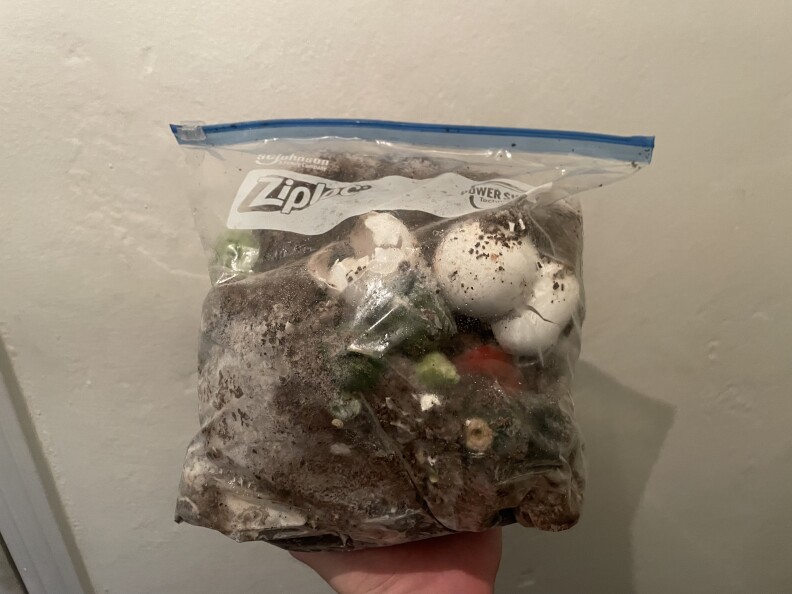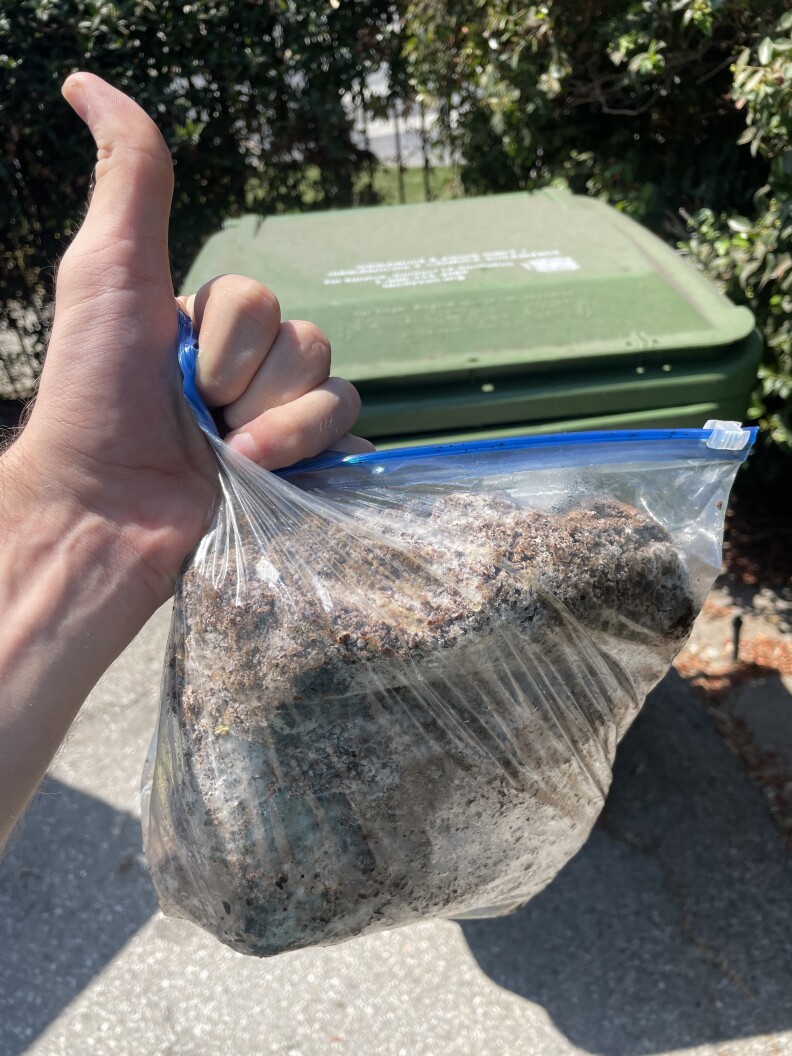-
Climate change is affecting our food, and our food is affecting the climate. LAist, together with NPR is dedicating a week to stories and conversations about the search for solutions.
Landfills are responsible for 20% of California’s methane, and cutting down on greenhouse gas emissions will be central in order for the state to meet its ambitious climate goals.
One way to do your part is composting, but there are some entry barriers: space, equipment, and perhaps most notably, the smell and pests that often go along with composting.
So as we wrap up our Climate Solutions Week this year, I wanted to stress how easy it is to get started composting in many cases — and I know this because I just started doing it myself.
My beginner’s setup
Even though it's now against the law to put my food scraps in the trash, I had a couple really good reasons not to start composting: smell and lack of a green bin. Living in a Koreatown studio apartment with no outdoor space and no communal composting setup made it next to impossible for me even to think about getting started.
But when my landlord finally installed a green bin — several months after it was required by the city, but I digress — I began looking into resources on composting, including LAist’s own extensive composting guide.
The missing element to take care of the smell issue was an easy fix: putting my compost in the freezer. What's more, this has the added benefit of keeping food scraps away from pests.
All you need is some sort of bag or receptacle — paper or plastic are both fine. In my experience, neither will smell up your freezer as long as the bag’s contents stay frozen. Paper is certainly more sustainable, though clear plastic bags may be easier for you if you’re in a city like Pasadena that requires you to put your compost in them, that way you won’t have to do anything besides dropping the bag in the green bin.
With that said, I started out with a sealable plastic Ziploc bag since I was being extra cautious about smelling up my freezer. It’s pretty self-explanatory, but one pro tip: You’ll want to avoid overfilling the bag so it’ll be easier to empty since the contents may be frozen together.

Another tip from our climate emergency reporter Erin Stone: If you need to put your compost in plastic bags but want to cut down on waste, you can put your compost in old bread bags, which are transparent enough to meet requirements for clear plastic. Also, be aware that Ziploc-style bags will not meet this requirement since they’re harder to rip open.
Leveling your composting game up
If you’re willing to make small investments of money or time, it won’t take too much to get an even better setup.
Using compostable paper bags, a cardboard box or a reusable plastic container would help keep waste to a minimum. (My Ziploc bags hold up unless I overfill them, but even then I'd likely need to replace them eventually, and that’s waste.) Having a dedicated container is also more aesthetically appealing than a couple plastic bags zipped up in the corner of my freezer.

One option to level up would be buying a Tupperware-style container, but Los Angeles residents can also claim a free composting bin. The city gives them away at select locations like libraries, and residents can set up an appointment at one of the pickup sites here.
If you’d rather try something a little more hands-on, you can break down your compost at home — the state has some tips for you if you decide to go that route. If you don’t mind keeping some worms around, you can use a vermicomposting system.
If you do notice unsavory smells emanating from your compost, here’s a few tips courtesy of the L.A. Department of Sanitation.
Inside your home:
- Use a paper towel or paper bag to line your kitchen pail.
- Sprinkle baking soda in your kitchen pail to reduce odors.
- Empty your kitchen pail into your green bin regularly and just before collection day.
- Wash your kitchen pail regularly. It is dishwasher friendly.
- Wrap smellier items and store in your refrigerator or freezer until collection day.
Outside your home:
- Put some yard trimmings in your green bin before and after adding your scraps.
- Place the green bin out for collection every week, even if not full.
- Rinse your green bin as needed and sprinkle baking soda in the bottom of the bin.
- Call LASAN's 24-hour Customer Care Center at 800-773-2489 for repair or replacement of broken bins.
The last step: your green bin
One crucial component of this beginner's guide is that my building does have a green bin. Since I don’t have a backyard or the dedication to try other methods, that was non-negotiable.
If your building is required to have a green bin and doesn’t, you can get in touch with your landlord and ask if they’ve requested one from the city . If some time passes and your landlord isn’t cooperating, you can report them to the city by calling L.A. Sanitation at (800) 773-2489. Homeowners without a green bin can start the process by calling the L.A. Sanitation’s customer service center at the same number.

There’s also the option of putting your waste in a green bin outside of your home. You can drop it off at many farmers’ markets around the city, or a neighbor with extra space in their bin might let you use it.
If you have any more questions about starting to compost or about the local and state laws requiring Californians to compost, see LAist’s composting guide.
Find compost laws for your area
- City of LA:
- Single-family homes
- Apartments (5-plus units) and businesses, served by recycLA
- Unincorporated areas of LA County
- Long Beach (service expected to start in 2025)
- Anaheim
- Unincorporated areas of Orange County
- City of Riverside
- Riverside County (unincorporated areas and various cities)
- Santa Ana
- Irvine
- Santa Clarita:
- City of San Bernardino
- Unincorporated areas of San Bernardino County
- Moreno Valley
- Fontana
Waste haulers:
- Athens Services: What Goes Where Guide, which is searchable by city
- CR&R Waste Services
- Waste Management
- Republic Services
- Burrtec
If you live in a city not included on this list, try searching “organics recycling” or “SB 1383” and the name of your city, county or waste hauler.
LAist takes the climate emergency seriously. And our coverage is unique because we took the time to listen to Southern Californians about their concerns. With more climate coverage than ever before, we are here for you every single day with stories that provide actionable information so you can make your everyday life better.
But we cannot do this essential work without your help. We rely on donations from readers like you to stay independent, which keeps our nonprofit newsroom strong and accountable to you.
At a time when the need for local journalism has never been greater, many newsrooms are facing cutbacks, including LAist. Member support – your support – is what will sustain a free press in Southern California.
LAist’s mission is to be here for you, so please be here for us now with a donation to power our trusted local reporting. Step up right now and make the choice to give. Because that’s exactly what it is - a choice. But it is not a choice without consequences. If readers do not choose to step up and donate, the future of fact-based news in Southern California will not be as strong.
No matter what happens in the world, LAist will remain a voice you know and trust.
Thank you for your generous support.
Sincerely,
-
(she/her)













